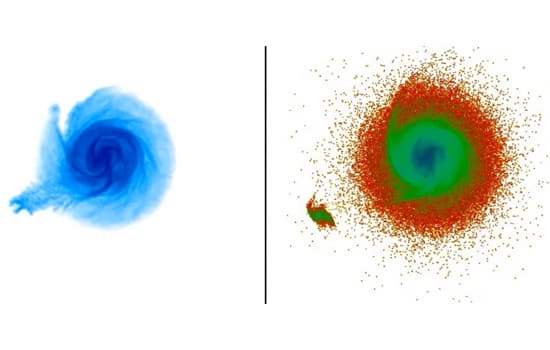New Method Studies Quakes In The Milky Way - Could Help Search Dark Matter
Similar to the phenomenon of earthquakes on Earth surface, the Milky way also seems to have experienced a galaxy quake a few hundred million years ago when a tiny dwarf galaxy packed with dark matter zoomed past it creating enormous seismic ripples in its outer gas disk. An international team of scientists from Rochester Institute of Technology led by an Indian-American professor Sukanya Chakrabarty has discovered a new method that may help and explain ripples in this outer disk of the galaxy and in detecting dwarf galaxies dominated by dark matter.

These are images of the Milky Way
Left one shows distribution of gas compared to the distribution of stars
Right shows what happens after the dwarf satellite disrupts the galaxy
The waves in the galactic disk are used to map the interior structure and mass of galaxies. The team used spectroscopic observations to calculate the speed of the three Cepheid variables— a trio of pulsating stars used as yardsticks to measure distance in galaxies—in the Norma constellation. The stars are thought to lie away in a dwarf galaxy 300,000 light years away from the Milky way. They are racing away at an average speed of 450,000 miles per hour; while the radial velocity of stars in the stellar disk of the Milky Way is about 13,000 miles per hour.
The researchers were thus able to calculate the speed of the stars as the pulsing light they produce is tied to their brightness, and so allows astronomers to calculate their distance. This suggests these stars as being part of an organised, fast-moving system, which researchers believe to be a dwarf galaxy.

(Sukanya Chakrabarty)
Chakrabarti’s earlier study predicted the location of the dark-matter dominated dwarf galaxy. Radiation emitted by the Cepheid variable stars allowed her to derive accurate distances and test her prediction.
The elusive dark matter makes about 23% of the mass of universe and is yet unknown. This method for locating satellite galaxies dominated by dark-matter taps principles used in seismology to explore the interior of the galaxy, something known as galactoseismology in the astronomy world by which we can infer the dark matter content of dwarf galaxies, where they are, as well as properties of the interior of galaxies by looking at observable disturbances in the gas disk.
The study further questions the standard paradigm that old stars populate the dark matter halo and young stars form in the gas-rich stellar disks.
There could be a population of yet undiscovered Cepheid variables that formed from a gas-rich dwarf galaxy falling into the halo, Sukanya was quoted as saying. The galaxies are very dynamic and continuously evolving, and there could be more evidence of young Cepheid variables being made in the halo due to fresh gas flowing in, or due to gas-rich dwarf galaxies merging with our own.
The findings were presented at the American Astronomical Society meeting in Kissimmee and have been submitted to Astrophysical Journal Letters. Spectroscopic observations used in the study were made at the Gemini Observatory and on the Magellan telescopes, as well as on the WiFeS spectrograph.
Source: #-Link-Snipped-#

These are images of the Milky Way
Left one shows distribution of gas compared to the distribution of stars
Right shows what happens after the dwarf satellite disrupts the galaxy
The waves in the galactic disk are used to map the interior structure and mass of galaxies. The team used spectroscopic observations to calculate the speed of the three Cepheid variables— a trio of pulsating stars used as yardsticks to measure distance in galaxies—in the Norma constellation. The stars are thought to lie away in a dwarf galaxy 300,000 light years away from the Milky way. They are racing away at an average speed of 450,000 miles per hour; while the radial velocity of stars in the stellar disk of the Milky Way is about 13,000 miles per hour.
The researchers were thus able to calculate the speed of the stars as the pulsing light they produce is tied to their brightness, and so allows astronomers to calculate their distance. This suggests these stars as being part of an organised, fast-moving system, which researchers believe to be a dwarf galaxy.

(Sukanya Chakrabarty)
Chakrabarti’s earlier study predicted the location of the dark-matter dominated dwarf galaxy. Radiation emitted by the Cepheid variable stars allowed her to derive accurate distances and test her prediction.
The elusive dark matter makes about 23% of the mass of universe and is yet unknown. This method for locating satellite galaxies dominated by dark-matter taps principles used in seismology to explore the interior of the galaxy, something known as galactoseismology in the astronomy world by which we can infer the dark matter content of dwarf galaxies, where they are, as well as properties of the interior of galaxies by looking at observable disturbances in the gas disk.
The study further questions the standard paradigm that old stars populate the dark matter halo and young stars form in the gas-rich stellar disks.
There could be a population of yet undiscovered Cepheid variables that formed from a gas-rich dwarf galaxy falling into the halo, Sukanya was quoted as saying. The galaxies are very dynamic and continuously evolving, and there could be more evidence of young Cepheid variables being made in the halo due to fresh gas flowing in, or due to gas-rich dwarf galaxies merging with our own.
The findings were presented at the American Astronomical Society meeting in Kissimmee and have been submitted to Astrophysical Journal Letters. Spectroscopic observations used in the study were made at the Gemini Observatory and on the Magellan telescopes, as well as on the WiFeS spectrograph.
Source: #-Link-Snipped-#
0
